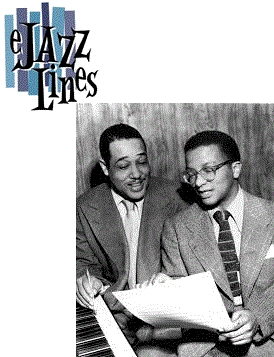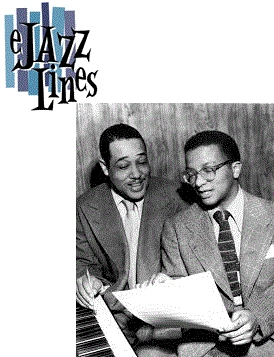Opens in a new window
Jazz Lines Publications Billy Strayhorn: Complete Set Of Seven Arrangements - Jazz Ensemble - Set of 7

Product Videos :
YouTube Video


- Composer/Author: ELLINGTON, DUKE
- Instrumentation: JAZZ ENSEMBLE
- Model # JLP-1018
Arranger: Billy Strayhorn
Edition: Seven Jazz Big Band Arrangements
Publisher: Jazz Lines Publications
Style: Swing/Ballad
Levels: Various
Strayhorn/Ellington music is some of the greatest of the 20th century, and Jazz Lines Publications is truly proud to be a part of publishing it. They now publish seven original Billy Strayhorn arrangements, and there will be more forthcoming.
The seven currently published are now available in a specially-priced complete set.
Contents:
- Agra
- This arrangement was written by Billy Strayhorn in 1963 and was first performed in Sweden on March 9, 1964. While on tour in Europe during that year Ellington introduced several pieces as Impressions of the Far East. At that time the Suite consisted of Amad, Agra, Bluebird of Delhi, and Depk. Agra and Bluebird of Delhi were written by Strayhorn and Amad and Depk were written by Ellington. As the notion for a full-length suite began to take shape several more pieces were composed: Ad Lib on Nippon and A Tourist Point of View, both composed by Ellington, and Mount Harissa and Blue Pepper, possibly composed by both Ellington and Strayhorn (scores have not been located for these two movements; hence, authorship is in question). Isfahan was recorded on December 20, 1966 to be included in the Far East Suite.This is a baritone saxophone feature, written to showcase Harry Carney. The baritone saxophone part is as-written by Billy Strayhorn with the exception of the cadenza beginning at measure 34. We encourage the soloist to ad-lib freely at this point in the arrangement. However, the transcribed cadenza may serve as a model of what may be considered appropriate. - Ballad - Medium
- Blood Count
- In early 1967 Strayhorn, who was suffering from esophagael cancer and the effects of radiation treatment, set out to compose a multi-movement work in which one of sections was to be titled Blue Cloud. A sketch of this movement (in Strayhorns hand) exists with that title. Perhaps realizing that due to his failing health he would most likely not be able to complete this extended work, in February 1967 he sent the score to Ellington to have parts extracted. At this time the piece was retitled Blood Count, evocative of his time spent in a hospital for cancer treatment. We do know that this title was Strayhorns as there exists a lead sheet in his handwriting bearing the name Blood Count. Ellington rehearsed this piece while traveling through Italy and then performed it live at a concert in Stuttgart, Germany on March 6, 1967. Ellington, who was on tour in Europe, further performed it at the Theatre Des Champs Elysees in Paris on March 10, 1967. Upon his return to New York, the ensemble played it live once again at Carnegie Hall in New York on March 26, 1967, this concert immortalized as part of the multi-disc set The Greatest Jazz Concert in the World. Billy Strayhorn died at 4:45 a.m. on May 31, 1967 at the Hospital for Joint Diseases in New York.
The Duke Ellington Orchestra would visit this arrangement just two more times: at a concert in Los Angeles on June 23, 1967 and then for the famous studio-recorded tribute to Strayhorn ...And His Mother Called Him Bill (New York, August 28, 1967).
This publication is derived from a sketch score, a lead sheet, an incomplete full score that may not be in Strayhorns hand, and the original parts with the names of the Ellington musicians in the top left-hand corner of each title page. Corrections had been marked by the players in some cases. - Ballad - Medium
- In early 1967 Strayhorn, who was suffering from esophagael cancer and the effects of radiation treatment, set out to compose a multi-movement work in which one of sections was to be titled Blue Cloud. A sketch of this movement (in Strayhorns hand) exists with that title. Perhaps realizing that due to his failing health he would most likely not be able to complete this extended work, in February 1967 he sent the score to Ellington to have parts extracted. At this time the piece was retitled Blood Count, evocative of his time spent in a hospital for cancer treatment. We do know that this title was Strayhorns as there exists a lead sheet in his handwriting bearing the name Blood Count. Ellington rehearsed this piece while traveling through Italy and then performed it live at a concert in Stuttgart, Germany on March 6, 1967. Ellington, who was on tour in Europe, further performed it at the Theatre Des Champs Elysees in Paris on March 10, 1967. Upon his return to New York, the ensemble played it live once again at Carnegie Hall in New York on March 26, 1967, this concert immortalized as part of the multi-disc set The Greatest Jazz Concert in the World. Billy Strayhorn died at 4:45 a.m. on May 31, 1967 at the Hospital for Joint Diseases in New York.
- Blue Serge
- In 1959 Mercer Ellington assembled his dad's working ensemble in a New York studio to record an album for Coral Records that is known as Colors in Rhythm. The idea was to take a few of Mercer's originals, along with some of Duke's tunes and a few standards and give them a new coat of paint. This arrangement of Mercer's tune Blue Serge was the only chart recorded during this session that was penned by Billy Strayhorn. This is a simple, but marvelous chart on the well-known Mercer Ellington composition. Strayhorn has flugelhorn (Clark Terry) and trumpet (Shorty Baker) state the melody for the first half of the tune. Following a trombone soli for the bridge, the baritone saxophone (Harry Carney) takes his/her turn with the melody. Throughout the entire chart there are wonderfully haunting backgrounds. - Ballad - Medium Easy
- The Bluebird of Delhi
- This arrangement was written by Billy Strayhorn (originally titled Mynah) is a tribute to a mynah bird that often visited his room while the band was in India. Jimmy Hamilton's clarinet evokes the sound and spirit of the bird, with Hamilton mimicking the pretty lick (in Ellingtons words) that the bird used to sing. This is a clarinet feature, written to showcase Jimmy Hamilton.
While on tour in Europe during that year Ellington introduced several pieces as Impressions of the Far East. At that time the Suite consisted of Amad, Agra, Bluebird of Delhi, and Depk. Agra and Bluebird of Delhi were written by Strayhorn and Amad and Depk were written by Ellington. As the notion for a full-length suite began to take shape several more pieces were composed: Ad Lib on Nippon and A Tourist Point of View, both composed by Ellington, and Mount Harissa and Blue Pepper, possibly composed by both Ellington and Strayhorn (scores have not been located for these two movements; hence, authorship is in question). Isfahan was recorded on December 20, 1966 to be included in the Far East Suite.
This publication is based on the original set of parts, Billy Strayhorn's handwritten sketch score, an engraved copyright deposit sketch score, and the 1966 studio recording. - Swing - Medium Difficult
- This arrangement was written by Billy Strayhorn (originally titled Mynah) is a tribute to a mynah bird that often visited his room while the band was in India. Jimmy Hamilton's clarinet evokes the sound and spirit of the bird, with Hamilton mimicking the pretty lick (in Ellingtons words) that the bird used to sing. This is a clarinet feature, written to showcase Jimmy Hamilton.
- Boo-Dah
- This arrangement was originally written in 1953 by Billy Strayhorn and featured clarinet and trumpet solos. Although it was recorded in the studio in 1953 and on several live occassions in 1965 (featuring clarinetist Jimmy Hamilton and trumpeter Cat Anderson) the most famous recording dates from the 1967 RCA studio session. This recording was released on the album ...And His Mother Called Him Bill, recorded shortly after Billy Strayhorn died. This recording featured the brilliant trumpet work of Clark Terry.
This publication is derived from an incomplete set of parts, a lead sheet (in Strayhorn's hand), a copyright deposit sheet (also in Strayhorn's hand) and recordings from 1953, 1965, and 1967. - Swing - Medium
- This arrangement was originally written in 1953 by Billy Strayhorn and featured clarinet and trumpet solos. Although it was recorded in the studio in 1953 and on several live occassions in 1965 (featuring clarinetist Jimmy Hamilton and trumpeter Cat Anderson) the most famous recording dates from the 1967 RCA studio session. This recording was released on the album ...And His Mother Called Him Bill, recorded shortly after Billy Strayhorn died. This recording featured the brilliant trumpet work of Clark Terry.
- Isfahan
- This arrangement, first known as Elf, was originally written sometime in 1963. It was first recorded in New York on July 18, 1963. The title had been changed to Isfahan sometime before the Duke Ellington bands performance on the English television program Jazz 625 on February 20, 1964. While on tour in Europe during that year Ellington introduced several pieces as Impressions of the Far East. At that time the Suite consisted of Amad, Agra, Bluebird of Delhi, and Depk. Agra and Bluebird of Delhi written by Strayhorn and Amad and Depk were written by Ellington. As the notion for a full-length suite began to take shape several more pieces were composed: Ad Lib on Nippon and A Tourist Point of View, both composed by Ellington, and Mount Harissa and Blue Pepper, possibly composed by both Ellington and Strayhorn (scores have not been located for these two movements; hence, authorship is in question). Isfahan was recorded on December 20, 1966 to be included in the Far East Suite.This is an alto saxophone feature, written to showcase Johnny Hodges. The alto saxophone part is as-written by Billy Strayhorn. We encourage the soloist to interpret the music as he/she sees fit, rather than mimic Hodges. As such we have resisted the temptation of including a transcription of Hodges's performance. While we feel solo transcriptions are important for educational purposes, playing them within the context of a performance of this work may not be desirable. A piano part has not been included; however, chord changes have been indicated in the bass part.
This tune wound up becoming a standard, having been recorded more than 200 times. The Ellington band, however, never revisited the arrangement after the 1966 recording. - Ballad - Medium
- This arrangement, first known as Elf, was originally written sometime in 1963. It was first recorded in New York on July 18, 1963. The title had been changed to Isfahan sometime before the Duke Ellington bands performance on the English television program Jazz 625 on February 20, 1964. While on tour in Europe during that year Ellington introduced several pieces as Impressions of the Far East. At that time the Suite consisted of Amad, Agra, Bluebird of Delhi, and Depk. Agra and Bluebird of Delhi written by Strayhorn and Amad and Depk were written by Ellington. As the notion for a full-length suite began to take shape several more pieces were composed: Ad Lib on Nippon and A Tourist Point of View, both composed by Ellington, and Mount Harissa and Blue Pepper, possibly composed by both Ellington and Strayhorn (scores have not been located for these two movements; hence, authorship is in question). Isfahan was recorded on December 20, 1966 to be included in the Far East Suite.This is an alto saxophone feature, written to showcase Johnny Hodges. The alto saxophone part is as-written by Billy Strayhorn. We encourage the soloist to interpret the music as he/she sees fit, rather than mimic Hodges. As such we have resisted the temptation of including a transcription of Hodges's performance. While we feel solo transcriptions are important for educational purposes, playing them within the context of a performance of this work may not be desirable. A piano part has not been included; however, chord changes have been indicated in the bass part.
- U.M.M.G.
- This arrangement of UMMG by Billy Strayhorn was written in 1956 for Duke Ellington and recorded during a session for Bethlehem Records. It was later recorded in 1959 for Columbia and then in 1967 for the tribute to Strayhorn entitled And His Mother Called Him Bill. This tune has become a jazz standard over the years. This chart was written to feature clarinetist Jimmy Hamilton, trumpeter Willie Cook (later Clark Terry), and baritone saxophonist Harry Carney. Typical of Strayhorn's arrangements, this chart features interesting dissonance and subtle band interplay. - Swing - Medium
Media
Youtube video product demo
Blue Serge
Press play to listen
Boo Dah
Press play to listen
U M M G
Press play to listen
Q & A
There are currently no questions for this product.
Reviews
There are currently no reviews for this product. Be the first to write one!




